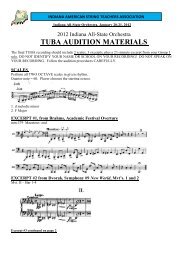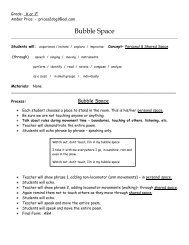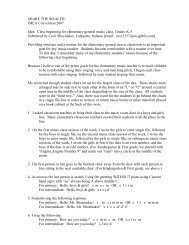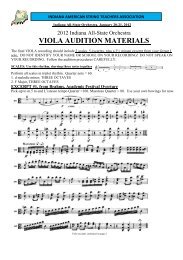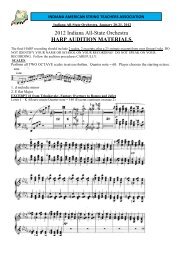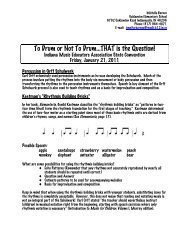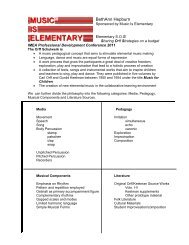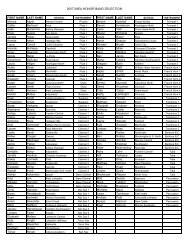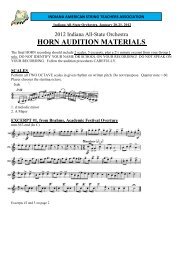no child left on his or her behind - Indiana Music Education ...
no child left on his or her behind - Indiana Music Education ...
no child left on his or her behind - Indiana Music Education ...
You also want an ePaper? Increase the reach of your titles
YUMPU automatically turns print PDFs into web optimized ePapers that Google loves.
DEBKY<br />
(Arabic)<br />
The debky is <strong>on</strong>e of the most comm<strong>on</strong> dances of the Arabic peoples, whet<strong>her</strong> they are<br />
Egyptian, J<strong>or</strong>danian, Palestinian, Lebanese, Syrian, <strong>or</strong> from ot<strong>her</strong> Arab lands, <strong>or</strong> whet<strong>her</strong><br />
they are expatriates in ot<strong>her</strong> nati<strong>on</strong>s. The w<strong>or</strong>d debky is sometimes called debke, dubka,<br />
debka, <strong>or</strong> ot<strong>her</strong> w<strong>or</strong>ds in different countries. (As it is transliterated from the Arabic<br />
alphabet, t<strong>her</strong>e may be spelling variants in English.)<br />
The Arabic w<strong>or</strong>d, dabk, means to stamp <strong>on</strong>e’s foot. T<strong>her</strong>e are many debky figures;<br />
each regi<strong>on</strong> has its own, and improvisati<strong>on</strong> is encouraged. Two basic patterns are described<br />
below. The first is a h<strong>or</strong>a figure comm<strong>on</strong> in the dances of sout<strong>her</strong>n Europe (e.g., Greece,<br />
Romania, Serbia, etc.) and western Asia (e.g., Armenia, Israel, Turkey, etc.). A h<strong>or</strong>a figure<br />
is a six-beat pattern <strong>on</strong> a four-beat measure with myriad variati<strong>on</strong>s.<br />
(F<strong>or</strong> ot<strong>her</strong> h<strong>or</strong>a-type dances in Sanna’s resources, see ―Hoy Nergiz/Toi Nergis‖<br />
from Armenia <strong>on</strong> t<strong>his</strong> CD and/<strong>or</strong> DVD/video, as well as the Israeli ―H<strong>or</strong>a‖ <strong>on</strong> Sanna’s<br />
DVD/video #1 (red) and CD #1, and the Greek ―Servihassapikos‖ <strong>on</strong> <strong>her</strong> DVD/video #3<br />
(aqua) and CD #1-1/2. DVD/video #3 and CD #1-1/2 also include a patterned debky dance,<br />
―Ya Abud‖).<br />
<strong>Music</strong>/DVD/video: On Sanna’s CD#3 and DVD/video#6, both Volume 1 in Dances of the<br />
Seven C<strong>on</strong>tinents. The music rec<strong>or</strong>ded <strong>her</strong>e is Egyptian, but the debky can be danced to<br />
numerous tunes with appropriate rhythm. It can also be an adjunct to Arabic<br />
drumming (tabla, dumbek, darabukah) less<strong>on</strong>s and perf<strong>or</strong>mances. Meter: 4/4<br />
F<strong>or</strong>mati<strong>on</strong>: Sh<strong>or</strong>t lines of perhaps five to eight people f<strong>or</strong> teaching purposes.<br />
Traditi<strong>on</strong>ally, lines <strong>or</strong> open circles may be sh<strong>or</strong>t <strong>or</strong> l<strong>on</strong>g—at parties they may snake around<br />
the room. Hands may be joined down at the side <strong>or</strong> clasped at the waist with dancers<br />
moving shoulder-to-shoulder in a tight f<strong>or</strong>mati<strong>on</strong> to the right (counterclockwise), but, again,<br />
with many variati<strong>on</strong>s. Sometimes pairs dance toget<strong>her</strong> inside <strong>or</strong> outside the circle. In some<br />
societies, women and men may dance in separate lines and groups, <strong>or</strong> even different rooms.<br />
Styling: Instead of the m<strong>or</strong>e h<strong>or</strong>iz<strong>on</strong>tal leaps and jumps of the Israeli and Greek h<strong>or</strong>as,<br />
debky steps are usually up-and-down, as well as sharp and powerful, with str<strong>on</strong>g stamps,<br />
hops, and kicks. Note that a stamp doesn’t take weight; the next step is <strong>on</strong> the same foot.<br />
One basic pattern (similar to H<strong>or</strong>a) Moving to the right (CCW), starting with R foot:<br />
Step R (ct 1), step L (ct 2), step R (ct 3), stamp L (ct 4), step L (ct 5), stamp R (ct 6).<br />
A<str<strong>on</strong>g>no</str<strong>on</strong>g>t<strong>her</strong> basic pattern Moving to the right (CCW), starting with L foot:<br />
Step L across R (ct 1), step <strong>on</strong> R (ct 2), step L across R (ct 3), step <strong>on</strong> R (ct 4), hop <strong>on</strong> R<br />
while bending L knee <strong>or</strong> kicking L foot f<strong>or</strong>ward (ct 5), stamp <strong>on</strong> L foot w/o weight (ct 6).<br />
Variati<strong>on</strong>s may include step-hops, double stamps, crossing steps, turns, etc.<br />
____________________________________<br />
PRESENTED BY SANNA LONGDEN. Notes by Sanna L<strong>on</strong>gden © 2006,<br />
with inf<strong>or</strong>mati<strong>on</strong> from Stephanie and Elias Abudayeh, and ot<strong>her</strong>s.<br />
EL JUEGO CHIRIMBOLO



